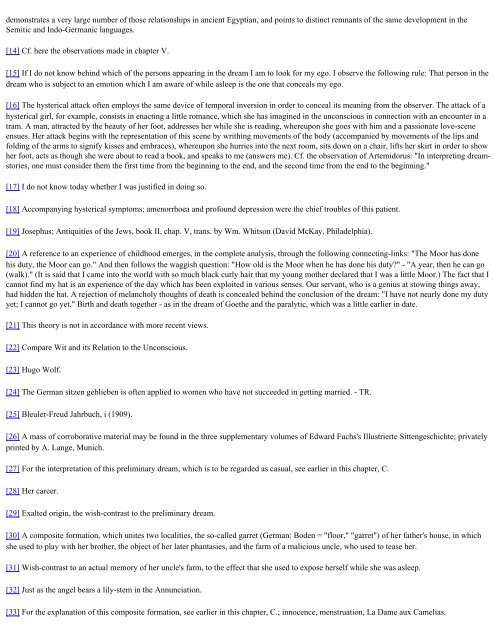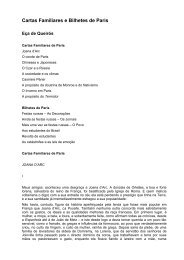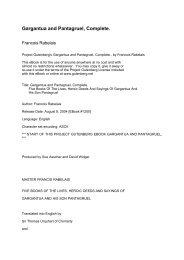The Interpretation of Dreams Sigmund Freud (1900)
The Interpretation of Dreams Sigmund Freud (1900)
The Interpretation of Dreams Sigmund Freud (1900)
Create successful ePaper yourself
Turn your PDF publications into a flip-book with our unique Google optimized e-Paper software.
demonstrates a very large number <strong>of</strong> those relationships in ancient Egyptian, and points to distinct remnants <strong>of</strong> the same development in the<br />
Semitic and Indo-Germanic languages.<br />
[14] Cf. here the observations made in chapter V.<br />
[15] If I do not know behind which <strong>of</strong> the persons appearing in the dream I am to look for my ego. I observe the following rule: That person in the<br />
dream who is subject to an emotion which I am aware <strong>of</strong> while asleep is the one that conceals my ego.<br />
[16] <strong>The</strong> hysterical attack <strong>of</strong>ten employs the same device <strong>of</strong> temporal inversion in order to conceal its meaning from the observer. <strong>The</strong> attack <strong>of</strong> a<br />
hysterical girl, for example, consists in enacting a little romance, which she has imagined in the unconscious in connection with an encounter in a<br />
tram. A man, attracted by the beauty <strong>of</strong> her foot, addresses her while she is reading, whereupon she goes with him and a passionate love-scene<br />
ensues. Her attack begins with the representation <strong>of</strong> this scene by writhing movements <strong>of</strong> the body (accompanied by movements <strong>of</strong> the lips and<br />
folding <strong>of</strong> the arms to signify kisses and embraces), whereupon she hurries into the next room, sits down on a chair, lifts her skirt in order to show<br />
her foot, acts as though she were about to read a book, and speaks to me (answers me). Cf. the observation <strong>of</strong> Artemidorus: "In interpreting dreamstories,<br />
one must consider them the first time from the beginning to the end, and the second time from the end to the beginning."<br />
[17] I do not know today whether I was justified in doing so.<br />
[18] Accompanying hysterical symptoms; amenorrhoea and pr<strong>of</strong>ound depression were the chief troubles <strong>of</strong> this patient.<br />
[19] Josephus; Antiquities <strong>of</strong> the Jews, book II, chap. V, trans. by Wm. Whitson (David McKay, Philadelphia).<br />
[20] A reference to an experience <strong>of</strong> childhood emerges, in the complete analysis, through the following connecting-links: "<strong>The</strong> Moor has done<br />
his duty, the Moor can go." And then follows the waggish question: "How old is the Moor when he has done his duty?" - "A year, then he can go<br />
(walk)." (It is said that I came into the world with so much black curly hair that my young mother declared that I was a little Moor.) <strong>The</strong> fact that I<br />
cannot find my hat is an experience <strong>of</strong> the day which has been exploited in various senses. Our servant, who is a genius at stowing things away,<br />
had hidden the hat. A rejection <strong>of</strong> melancholy thoughts <strong>of</strong> death is concealed behind the conclusion <strong>of</strong> the dream: "I have not nearly done my duty<br />
yet; I cannot go yet." Birth and death together - as in the dream <strong>of</strong> Goethe and the paralytic, which was a little earlier in date.<br />
[21] This theory is not in accordance with more recent views.<br />
[22] Compare Wit and its Relation to the Unconscious.<br />
[23] Hugo Wolf.<br />
[24] <strong>The</strong> German sitzen geblieben is <strong>of</strong>ten applied to women who have not succeeded in getting married. - TR.<br />
[25] Bleuler-<strong>Freud</strong> Jahrbuch, i (1909).<br />
[26] A mass <strong>of</strong> corroborative material may be found in the three supplementary volumes <strong>of</strong> Edward Fuchs's Illustrierte Sittengeschichte; privately<br />
printed by A. Lange, Munich.<br />
[27] For the interpretation <strong>of</strong> this preliminary dream, which is to be regarded as casual, see earlier in this chapter, C.<br />
[28] Her career.<br />
[29] Exalted origin, the wish-contrast to the preliminary dream.<br />
[30] A composite formation, which unites two localities, the so-called garret (German: Boden = "floor," "garret") <strong>of</strong> her father's house, in which<br />
she used to play with her brother, the object <strong>of</strong> her later phantasies, and the farm <strong>of</strong> a malicious uncle, who used to tease her.<br />
[31] Wish-contrast to an actual memory <strong>of</strong> her uncle's farm, to the effect that she used to expose herself while she was asleep.<br />
[32] Just as the angel bears a lily-stem in the Annunciation.<br />
[33] For the explanation <strong>of</strong> this composite formation, see earlier in this chapter, C.; innocence, menstruation, La Dame aux Camelias.









